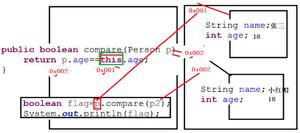20177113李清华《面向对象程序设计(java)》第八周学习总结

实验六 接口的定义与使用
实验时间 2018-10-18
1、实验目的与要求
(1) 掌握接口定义方法;
(2) 掌握实现接口类的定义要求;
(3) 掌握实现了接口类的使用要求;
(4) 掌握程序回调设计模式;
(5) 掌握Comparator接口用法;
(6) 掌握对象浅层拷贝与深层拷贝方法;
(7) 掌握Lambda表达式语法;
(8) 了解内部类的用途及语法要求。
2、实验内容和步骤
实验1: 导入第6章示例程序,测试程序并进行代码注释。
测试程序1:
l 编辑、编译、调试运行阅读教材214页-215页程序6-1、6-2,理解程序并分析程序运行结果;
l 在程序中相关代码处添加新知识的注释。
l 掌握接口的实现用法;
l 掌握内置接口Compareable的用法。
实验代码:
package interfaces;
import java.util.*;
/**
* This program demonstrates the use of the Comparable interface.
* @version 1.30 2004-02-27
* @author Cay Horstmann
*/
public class EmployeeSortTest
{
public static void main(String[] args)
{
Employee[] staff = new Employee[3];
staff[0] = new Employee("Harry Hacker", 35000);
staff[1] = new Employee("Carl Cracker", 75000);
staff[2] = new Employee("Tony Tester", 38000);
Arrays.sort(staff);//对数组元素排序
// 打印所有员工对象的信息
for (Employee e : staff)
System.out.println("name=" + e.getName() + ",salary=" + e.getSalary());
}
}
package interfaces;
//Employee实现内置接口Comparable
public class Employee implements Comparable<Employee>
{
private String name;
private double salary;
public Employee(String name, double salary)
{
this.name = name;
this.salary = salary;
}
public String getName()
{
return name;
}
public double getSalary()
{
return salary;
}
public void raiseSalary(double byPercent)
{
double raise = salary * byPercent / 100;
salary += raise;
}
/**
* Compares employees by salary
* @param other another Employee object
* @return a negative value if this employee has a lower salary than
* otherObject, 0 if the salaries are the same, a positive value otherwise
*/
//进行比较必须实现这个方法
public int compareTo(Employee other)
{
return Double.compare(salary, other.salary);
}
}
实验结果:
测试程序2:
l 编辑、编译、调试以下程序,结合程序运行结果理解程序;
1 interface A2 {
3 double g=9.8;
4 void show( );
5 }
6 class C implements A
7 {
8 public void show( )
9 {System.out.println("g="+g);}
10 }
11
12 class InterfaceTest
13 {
14 public static void main(String[ ] args)
15 {
16 A a=new C( );
17 a.show( );
18 System.out.println("g="+C.g);
19 }
20 }
1 package e;2
3 public class InterfaceTest
4 {
5 public static void main(String[ ] args)
6 {
7 A a=new C( );//定义一个类C的实例并赋给接口A的对象变量
8 a.show( );
9 System.out.println("g="+C.g);//直接调用类的属性
10 }
11 }
1 package e;2
3 public interface A
4 {
5 double g=9.8;
6 void show( );
7 }
package e;public class C implements A
{
public void show( )
{System.out.println("g="+g);}
}
实验结果:
测试程序3:
l 在elipse IDE中调试运行教材223页6-3,结合程序运行结果理解程序;
l 26行、36行代码参阅224页,详细内容涉及教材12章。
l 在程序中相关代码处添加新知识的注释。
l 掌握回调程序设计模式;
实验代码:
1 package timer;2
3 /**
4 @version 1.01 2015-05-12
5 @author Cay Horstmann
6 */
7
8 import java.awt.*;
9 import java.awt.event.*;
10 import java.util.*;
11 import javax.swing.*;
12 import javax.swing.Timer;
13 // 用JavaUTIL计时器解决冲突
14
15 public class TimerTest
16 {
17 public static void main(String[] args)
18 {
19 ActionListener listener = new TimePrinter();
20
21 // 构建一个调用侦听器的计时器
22 //每10秒一次
23 Timer t = new Timer(10000, listener);
24 t.start();
25
26 JOptionPane.showMessageDialog(null, "Quit program?");
27 System.exit(0);
28 }
29 }
30
31 class TimePrinter implements ActionListener
32 {
33 public void actionPerformed(ActionEvent event)
34 {
35 System.out.println("At the tone, the time is " + new Date());
36 Toolkit.getDefaultToolkit().beep();
37 }
38 }
实验结果:
测试程序4:
l 调试运行教材229页-231页程序6-4、6-5,结合程序运行结果理解程序;
l 在程序中相关代码处添加新知识的注释。
l 掌握对象克隆实现技术;
l 掌握浅拷贝和深拷贝的差别。
1 package clone;2
3 /**
4 * This program demonstrates cloning.
5 * @version 1.10 2002-07-01
6 * @author Cay Horstmann
7 */
8 public class CloneTest
9 {
10 public static void main(String[] args)
11 {
12 //try...catch...语句,try代码区如果有错误,就会返回所写异常的处理。
13 //提高程序的健壮性
14 try
15 {
16 Employee original = new Employee("John Q. Public", 50000);
17 original.setHireDay(2000, 1, 1);
18 Employee copy = original.clone();
19 copy.raiseSalary(10);
20 copy.setHireDay(2002, 12, 31);
21 System.out.println("original=" + original);
22 System.out.println("copy=" + copy);
23 }
24 catch (CloneNotSupportedException e)
25 {
26 e.printStackTrace();
27 }
28 }
29 }
1 package clone;2
3 import java.util.Date;
4 import java.util.GregorianCalendar;
5
6 public class Employee implements Cloneable
7 {
8 private String name;
9 private double salary;
10 private Date hireDay;
11
12 public Employee(String name, double salary)
13 {
14 this.name = name;
15 this.salary = salary;
16 hireDay = new Date();
17 }
18
19 public Employee clone() throws CloneNotSupportedException//无论目标类是否实现了Cloneable接口,只要调用到了Object.clone(),比如通过super.clone(),那么就必须处理或者抛出CloneNotSupportedException,因为Object.clone()有throws这个异常,有抛的就必然有接的。
20
21 {
22 // call Object.clone()
23 Employee cloned = (Employee) super.clone();
24
25 // clone mutable fields
26 cloned.hireDay = (Date) hireDay.clone();
27
28 return cloned;
29 }
30
31 /**
32 * Set the hire day to a given date.
33 * @param year the year of the hire day
34 * @param month the month of the hire day
35 * @param day the day of the hire day
36 */
37 public void setHireDay(int year, int month, int day)
38 {
39 Date newHireDay = new GregorianCalendar(year, month - 1, day).getTime();
40
41 // 实例字段突变示例
42 hireDay.setTime(newHireDay.getTime());
43 }
44
45 public void raiseSalary(double byPercent)
46 {
47 double raise = salary * byPercent / 100;
48 salary += raise;
49 }
50
51 public String toString()
52 {
53 return "Employee[name=" + name + ",salary=" + salary + ",hireDay=" + hireDay + "]";
54 }
55 }
实验结果:
实验2: 导入第6章示例程序6-6,学习Lambda表达式用法。
l 调试运行教材233页-234页程序6-6,结合程序运行结果理解程序;
l 在程序中相关代码处添加新知识的注释。
l 将27-29行代码与教材223页程序对比,将27-29行代码与此程序对比,体会Lambda表达式的优点。
1 package lambda;2
3 import java.util.*;
4
5 import javax.swing.*;
6 import javax.swing.Timer;
7
8 /**
9 * This program demonstrates the use of lambda expressions.
10 * @version 1.0 2015-05-12
11 * @author Cay Horstmann
12 */
13 public class LambdaTest
14 {
15 public static void main(String[] args)
16 {
17 String[] planets = new String[] { "Mercury", "Venus", "Earth", "Mars",
18 "Jupiter", "Saturn", "Uranus", "Neptune" };
19 System.out.println(Arrays.toString(planets));
20 System.out.println("Sorted in dictionary order:");
21 Arrays.sort(planets);
22 System.out.println(Arrays.toString(planets));
23 System.out.println("Sorted by length:");
24 Arrays.sort(planets, (first, second) -> first.length() - second.length());
25 System.out.println(Arrays.toString(planets));
26 //Lambda表达式
27 Timer t = new Timer(1000, event ->
28 System.out.println("The time is " + new Date()));
29 t.start();
30
31 // 保持程序运行直到用户选择“OK”
32 JOptionPane.showMessageDialog(null, "Quit program?");
33 System.exit(0);
34 }
35 }
实验结果:
注:以下实验课后完成
实验3: 编程练习
l 编制一个程序,将身份证号.txt 中的信息读入到内存中;
l 按姓名字典序输出人员信息;
l 查询最大年龄的人员信息;
l 查询最小年龄人员信息;
l 输入你的年龄,查询身份证号.txt中年龄与你最近人的姓名、身份证号、年龄、性别和出生地;
l 查询人员中是否有你的同乡。
package test1;import java.io.BufferedReader;
import java.io.File;
import java.io.FileInputStream;
import java.io.FileNotFoundException;
import java.io.IOException;
import java.io.InputStreamReader;
import java.util.ArrayList;
import java.util.Collections;
import java.util.Scanner;
public class Main{
private static ArrayList<Student> studentlist;
public static void main(String[] args) {
studentlist = new ArrayList<>();
Scanner scanner = new Scanner(System.in);
File file = new File("F:\\身份证号.txt");
try {
FileInputStream fis = new FileInputStream(file);
BufferedReader in = new BufferedReader(new InputStreamReader(fis));
String temp = null;
while ((temp = in.readLine()) != null) {
Scanner linescanner = new Scanner(temp);
linescanner.useDelimiter(" ");
String name = linescanner.next();
String number = linescanner.next();
String sex = linescanner.next();
String age = linescanner.next();
String province =linescanner.nextLine();
Student student = new Student();
student.setName(name);
student.setnumber(number);
student.setsex(sex);
int a = Integer.parseInt(age);
student.setage(a);
student.setprovince(province);
studentlist.add(student);
}
} catch (FileNotFoundException e) {
System.out.println("学生信息文件找不到");
e.printStackTrace();
} catch (IOException e) {
System.out.println("学生信息文件读取错误");
e.printStackTrace();
}
boolean isTrue = true;
while (isTrue) {
System.out.println("选择你的操作,输入正确格式的选项");
System.out.println("A.按姓名字典排序");
System.out.println("B.输出年龄最大和年龄最小的人");
System.out.println("C.寻找老乡");
System.out.println("D.寻找年龄相近的人");
System.out.println("F.退出");
String m = scanner.next();
switch (m) {
case "A":
Collections.sort(studentlist);
System.out.println(studentlist.toString());
break;
case "B":
int max=0,min=100;
int j,k1 = 0,k2=0;
for(int i=1;i<studentlist.size();i++)
{
j=studentlist.get(i).getage();
if(j>max)
{
max=j;
k1=i;
}
if(j<min)
{
min=j;
k2=i;
}
}
System.out.println("年龄最大:"+studentlist.get(k1));
System.out.println("年龄最小:"+studentlist.get(k2));
break;
case "C":
System.out.println("老家?");
String find = scanner.next();
String place=find.substring(0,3);
for (int i = 0; i <studentlist.size(); i++)
{
if(studentlist.get(i).getprovince().substring(1,4).equals(place))
System.out.println("老乡"+studentlist.get(i));
}
break;
case "D":
System.out.println("年龄:");
int yourage = scanner.nextInt();
int near=agenear(yourage);
int value=yourage-studentlist.get(near).getage();
System.out.println(""+studentlist.get(near));
break;
case "F":
isTrue = false;
System.out.println("退出程序!");
break;
default:
System.out.println("输入有误");
}
}
}
public static int agenear(int age) {
int j=0,min=53,value=0,k=0;
for (int i = 0; i < studentlist.size(); i++)
{
value=studentlist.get(i).getage()-age;
if(value<0) value=-value;
if (value<min)
{
min=value;
k=i;
}
}
return k;
}
}
package test1;public class Student implements Comparable<Student> {
private String name;
private String number ;
private String sex ;
private int age;
private String province;
public String getName() {
return name;
}
public void setName(String name) {
this.name = name;
}
public String getnumber() {
return number;
}
public void setnumber(String number) {
this.number = number;
}
public String getsex() {
return sex ;
}
public void setsex(String sex ) {
this.sex =sex ;
}
public int getage() {
return age;
}
public void setage(int age) {
// int a = Integer.parseInt(age);
this.age= age;
}
public String getprovince() {
return province;
}
public void setprovince(String province) {
this.province=province ;
}
public int compareTo(Student o) {
return this.name.compareTo(o.getName());
}
public String toString() {
return name+"\t"+sex+"\t"+age+"\t"+number+"\t"+province+"\n";
}
}
实验结果:
实验4:内部类语法验证实验
实验程序1:
l 编辑、调试运行教材246页-247页程序6-7,结合程序运行结果理解程序;
l 了解内部类的基本用法。
1 package innerClass;2
3 import java.awt.*;
4 import java.awt.event.*;
5 import java.util.*;
6 import javax.swing.*;
7 import javax.swing.Timer;
8
9 /**
10 * This program demonstrates the use of inner classes.
11 * @version 1.11 2015-05-12
12 * @author Cay Horstmann
13 */
14 public class InnerClassTest
15 {
16 public static void main(String[] args)
17 {
18 TalkingClock clock = new TalkingClock(1000, true);
19 clock.start();
20
21 // keep program running until user selects "Ok"
22 JOptionPane.showMessageDialog(null, "Quit program?");
23 System.exit(0);
24 }
25 }
26
27 /**
28 * A clock that prints the time in regular intervals.
29 */
30 class TalkingClock
31 {
32 private int interval;
33 private boolean beep;
34
35 /**
36 * Constructs a talking clock
37 * @param interval the interval between messages (in milliseconds)
38 * @param beep true if the clock should beep
39 */
40 public TalkingClock(int interval, boolean beep)
41 {
42 this.interval = interval;
43 this.beep = beep;
44 }
45
46 /**
47 * Starts the clock.
48 */
49 public void start()
50 {
51 ActionListener listener = new TimePrinter();
52 Timer t = new Timer(interval, listener);
53 t.start();
54 }
55
56 public class TimePrinter implements ActionListener
57 {
58 public void actionPerformed(ActionEvent event)
59 {
60 System.out.println("At the tone, the time is " + new Date());
61 if (beep) Toolkit.getDefaultToolkit().beep();
62 }
63 }
64 }
实验结果:
实验程序2:
l 编辑、调试运行教材254页程序6-8,结合程序运行结果理解程序;
l 了解匿名内部类的用法。
1 package anonymousInnerClass;2
3 import java.awt.*;
4 import java.awt.event.*;
5 import java.util.*;
6 import javax.swing.*;
7 import javax.swing.Timer;
8
9 /**
10 * This program demonstrates anonymous inner classes.
11 * @version 1.11 2015-05-12
12 * @author Cay Horstmann
13 */
14 public class AnonymousInnerClassTest
15 {
16 public static void main(String[] args)
17 {
18 TalkingClock clock = new TalkingClock();
19 clock.start(1000, true);
20
21 // keep program running until user selects "Ok"
22 JOptionPane.showMessageDialog(null, "Quit program?");
23 System.exit(0);
24 }
25 }
26
27 /**
28 * A clock that prints the time in regular intervals.
29 */
30 class TalkingClock
31 {
32 /**
33 * Starts the clock.
34 * @param interval the interval between messages (in milliseconds)
35 * @param beep true if the clock should beep
36 */
37 public void start(int interval, boolean beep)
38 {
39 ActionListener listener = new ActionListener()
40 {
41 public void actionPerformed(ActionEvent event)
42 {
43 System.out.println("At the tone, the time is " + new Date());
44 if (beep) Toolkit.getDefaultToolkit().beep();
45 }
46 };
47 Timer t = new Timer(interval, listener);
48 t.start();
49 }
50 }
实验程序3:
l 在elipse IDE中调试运行教材257页-258页程序6-9,结合程序运行结果理解程序;
l 了解静态内部类的用法。
1 package staticInnerClass;2
3 /**
4 * This program demonstrates the use of static inner classes.
5 * @version 1.02 2015-05-12
6 * @author Cay Horstmann
7 */
8 public class StaticInnerClassTest
9 {
10 public static void main(String[] args)
11 {
12 double[] d = new double[20];
13 for (int i = 0; i < d.length; i++)
14 d[i] = 100 * Math.random();
15 ArrayAlg.Pair p = ArrayAlg.minmax(d);
16 System.out.println("min = " + p.getFirst());
17 System.out.println("max = " + p.getSecond());
18 }
19 }
20
21 class ArrayAlg
22 {
23 /**
24 * A pair of floating-point numbers
25 */
26 public static class Pair
27 {
28 private double first;
29 private double second;
30
31 /**
32 * Constructs a pair from two floating-point numbers
33 * @param f the first number
34 * @param s the second number
35 */
36 public Pair(double f, double s)
37 {
38 first = f;
39 second = s;
40 }
41
42 /**
43 * Returns the first number of the pair
44 * @return the first number
45 */
46 public double getFirst()
47 {
48 return first;
49 }
50
51 /**
52 * Returns the second number of the pair
53 * @return the second number
54 */
55 public double getSecond()
56 {
57 return second;
58 }
59 }
60
61 /**
62 * Computes both the minimum and the maximum of an array
63 * @param values an array of floating-point numbers
64 * @return a pair whose first element is the minimum and whose second element
65 * is the maximum
66 */
67 public static Pair minmax(double[] values)
68 {
69 double min = Double.POSITIVE_INFINITY;
70 double max = Double.NEGATIVE_INFINITY;
71 for (double v : values)
72 {
73 if (min > v) min = v;
74 if (max < v) max = v;
75 }
76 return new Pair(min, max);
77 }
78 }
实验总结:
通过这次试验,理解了接口和抽象类的区别,掌握了回调,对象克隆的概念。知道了浅层拷贝和深层拷贝的区别。还需要继续学习Lambda表达式,这个知识点没有掌握。
以上是 20177113李清华《面向对象程序设计(java)》第八周学习总结 的全部内容, 来源链接: utcz.com/z/392036.html








